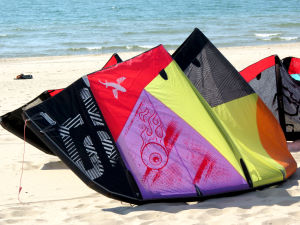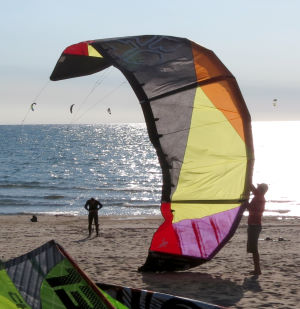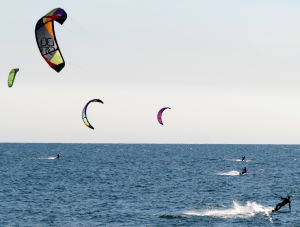The Benefit of Kiteboarding in Low Winds
The Benefit of Kiteboarding in Low Winds
 It happens to everyone. The forecast is calling for a consistent 15 to 20 knots in the morning; perfect kiteboarding conditions. You set your alarm clock to go off an hour before the sun rises, giving yourself time to drive to the beach and get a kiteboarding kite pumped up to greet the dawn. You make sure your car is packed with your favorite kitesurfing gear, plus your big kite/board just in case, even though you know you won't need it. You make sure your wallet, keys, and phone are all in a centralized location, and if you're anything like me, you have a change of clothes and small toiletries bag set aside, knowing you're going to be cutting it close to making it to work on time. Everything is primed for the perfect session.
It happens to everyone. The forecast is calling for a consistent 15 to 20 knots in the morning; perfect kiteboarding conditions. You set your alarm clock to go off an hour before the sun rises, giving yourself time to drive to the beach and get a kiteboarding kite pumped up to greet the dawn. You make sure your car is packed with your favorite kitesurfing gear, plus your big kite/board just in case, even though you know you won't need it. You make sure your wallet, keys, and phone are all in a centralized location, and if you're anything like me, you have a change of clothes and small toiletries bag set aside, knowing you're going to be cutting it close to making it to work on time. Everything is primed for the perfect session.
Arriving the next day, you quickly haul your gear down to the beach. Admittedly, the wind isn't quite what was forecasted, but it'll probably increase - after all, it's early still. Pumping up your 12 meter and jumping on your standard board, you find yourself slogging across the water, with every tack finding you further and further from your base camp. After a defeated walk back upwind, you make the painful decision to land your kite and pump up your light wind option. Jogging to your car, you think how everyone told you kiteboarding was supposed to be fun. Thank goodness you brought the big bird. By the time your large sail is in the air, the wind has died even further. Exasperated, you look to the sky and curse kiteboarding, preparing to give up for the day.
Wait! Before you do, know that there are a myriad of skills that you can practice and refine in underpowered conditions. While frustrating, lightwind sessions are great incubators for strengthening not only your kite flying ability, but your board skills as well. For myself, many of my favorite sessions are directly linked to skills I learned in a low wind session a day or two before.
 One of the largest benefits of a light wind day is the familiarity you can gain with your kite with little to no consequences. With low surface wind, relaunching becomes much more of an art form, requiring far more finesse than merely tugging on a steering or outside line. Rather, it allows you to practice rolling the kite on its back and launching in a fashion very similar to what the old c-kites required. You can also try reverse-launching, which involves grabbing the outside lines at an equal point about a foot or two from the bar and pulling at the same time. If done correctly, the kite will rise upside down from the ground, at which point you have to feed one line slowly from your hand to steer the kite right-side up. Much the same logic applies to using your safety features and self-landing the kite. You can experiment freely with your kiteboarding kite, liberated from the consequences that higher wind speeds bring.
One of the largest benefits of a light wind day is the familiarity you can gain with your kite with little to no consequences. With low surface wind, relaunching becomes much more of an art form, requiring far more finesse than merely tugging on a steering or outside line. Rather, it allows you to practice rolling the kite on its back and launching in a fashion very similar to what the old c-kites required. You can also try reverse-launching, which involves grabbing the outside lines at an equal point about a foot or two from the bar and pulling at the same time. If done correctly, the kite will rise upside down from the ground, at which point you have to feed one line slowly from your hand to steer the kite right-side up. Much the same logic applies to using your safety features and self-landing the kite. You can experiment freely with your kiteboarding kite, liberated from the consequences that higher wind speeds bring.
Another boon of kiteboarding in light winds is that it forces you to be a more efficient kite surfer. To hold a tack or even sneak upwind, you have to concentrate hard on form, such as not sticking your backside out, or putting more pressure on your back foot to allow your front leg to drive upwind. One of the most valuable skills I've gained from this is balancing planing flat on my kiteboard when I need to generate greater power, then when powered creating more of an edge to push upwind. This balancing act is something easily overlooked when kiteboarding with ample power.
Besides making me more proficient at kitesurfing in marginal winds, the same skill has transitioned directly over to throwing tricks, bettering my ability to plane out, then load up and explosively pop off of the water. Just as it helps with riding, lightwind kiteboarding also helps with tricks. With much of the power removed, it requires you to concentrate much more on the fundamentals of the trick. For example, if initiating a back-roll in underpowered conditions, it'll require you to maximize both the release from the water, as well as the rotation. Fine tuning these will only lead to more fluid tricks when the conditions are ideal.
Finally, low wind days provide an excellent environment for trying out tricks you normally wouldn't have the courage to on the water. My first experiences unhooking, kitelooping, and handle-passing all originated on low wind days. The caveat of course is to be conscious of your environment, making sure it is completely clear of people and obstacles, and to be careful, as you can still hurt yourself. Still, practicing these skills gave me not only a clear idea of what to expect, but the confidence to try them.
 Despite all this, as kiteboarders we will always prefer the windy days to marginal conditions. However, if you have set aside a portion of your day, and happen to find yourself in less-than-ideal wind speeds, make the most of it. Chalk it up to preparing yourself for your next session. You may even get lucky, and the wind may suddenly come up on you, granting you that coveted solo session after everyone else has packed up and gone home. Even still, practice on those low wind days. I guarantee you'll see the improvement in your next session.
Despite all this, as kiteboarders we will always prefer the windy days to marginal conditions. However, if you have set aside a portion of your day, and happen to find yourself in less-than-ideal wind speeds, make the most of it. Chalk it up to preparing yourself for your next session. You may even get lucky, and the wind may suddenly come up on you, granting you that coveted solo session after everyone else has packed up and gone home. Even still, practice on those low wind days. I guarantee you'll see the improvement in your next session.
Jake Mitchell
Age: 23
Weight: 180
Years Kiteboarding: 3
Favorite Lightwind Progression Kite: 2013 Best TS
